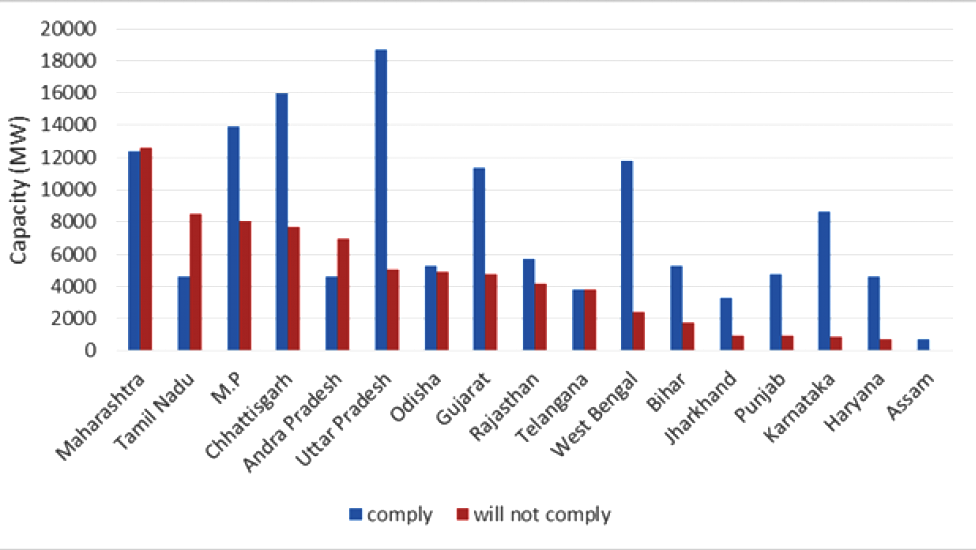Biodiversity & Environment
Meeting Emission Norms: Coal-based Power Plants
- 08 Jan 2022
- 6 min read
For Prelims: Sulfur Dioxide Pollution and its impact, Central Pollution Control Board (CPCB).
For Mains: Need to focus on mitigating the hazards of air pollution in India.
Why in News
According to the analysis by the Centre for Science and Environment (CSE), a Delhi-based non-profit, 61% of the coal-based power plants located near million-plus population cities, which have to meet their emission standards by December 2022, will miss their deadlines.
Key Points
- Background:
- The Ministry of Environment, Forest and Climate Change (MoEF&CC) had in 2015 set new emission norms and fixed a deadline to meet it.
- India initially had set a 2017 deadline for thermal power plants to comply with emissions standards for installing Flue Gas Desulphurization (FGD) units that cut emissions of toxic sulphur dioxide.
- This was later changed to varying deadlines for different regions, ending in 2022.
- Categorisation of Power Plants:
- Category A:
- The power plants which have to meet the December 2022 target are those which are located within 10 km radius of the National Capital Region (NCR) or cities having million-plus population.
- There are 79 coal-based power plants in this category as per a categorisation list of a task force, constituted by the Central Pollution Control Board (CPCB).
- The power plants which have to meet the December 2022 target are those which are located within 10 km radius of the National Capital Region (NCR) or cities having million-plus population.
- Category B and C:
- 68 power plants have been put in Category B (compliance deadline of December 2023) and 449 in Category C (compliance deadline of December 2024).
- The power plants which are located within 10 km radius of critically polluted areas or non-attainment cities fall under category B while the rest others (75% of total) fall in category C.
- 68 power plants have been put in Category B (compliance deadline of December 2023) and 449 in Category C (compliance deadline of December 2024).
- Category A:
- CSE Analysis:
- Major Defaulters:
- Maharashtra, Tamil Nadu, Madhya Pradesh, Chhattisgarh and Andhra Pradesh.
- These defaulting stations are run largely by the respective state governments.
- At least 17 Indian states have coal-based thermal power stations. A state-wise comparison highlighted the following:
- Except for Assam (AS), none of the other states among these 17 will 100% comply with the stipulated deadlines. This state has a 750-megawatt power station that makes it an insignificant per cent of total coal capacity.
- Maharashtra, Tamil Nadu, Madhya Pradesh, Chhattisgarh and Andhra Pradesh.
- Major Defaulters:
- State-run units on the wrong:
- A majority of the coal thermal power capacity that is likely to meet the norms belongs to the central sector followed by the private sector.
- Among the plants belonging to the state sector, some have floated the tender or at various stages of a feasibility study or simply have not framed any action plan to date.
- A majority of the coal thermal power capacity that is likely to meet the norms belongs to the central sector followed by the private sector.
- Impact of Penalty Mechanism:
- The penalty imposed on non-compliant units will be more feasible to pay rather than bearing the legalised cost of retrofit of pollution control equipment (FGD) to meet the new norms.
- The April 2021 notification also introduced a penalty mechanism or environmental compensation for plants that will not meet the respective deadlines, in addition to revising the deadlines.
- The environmental compensation that will be levied too will fail to act as deterrence for this expected non-compliance as it is too meagre as compared to the cost of effective emission control by a coal thermal power plant.
- The penalty imposed on non-compliant units will be more feasible to pay rather than bearing the legalised cost of retrofit of pollution control equipment (FGD) to meet the new norms.
Sulfur Dioxide Pollution
- Source:
- The largest source of SO2 in the atmosphere is the burning of fossil fuels by power plants and other industrial facilities.
- Smaller sources of SO2 emissions include: industrial processes such as extracting metal from ore, natural sources such as volcanoes, and locomotives, ships and other vehicles and heavy equipment that burn fuel with a high sulfur content.
- Impact: SO2 can affect both health and the environment.
- Short-term exposures to SO2 can harm the human respiratory system and make breathing difficult. People with asthma, particularly children, are sensitive to these effects of SO2.
- SO2 emissions that lead to high concentrations of SO2 in the air generally also lead to the formation of other sulfur oxides (SOx). SOx can react with other compounds in the atmosphere to form small particles. These particles contribute to Particulate Matter (PM) pollution.
- Small particles may penetrate deeply into the lungs and in sufficient quantities can contribute to health problems.
- India’s Case:
- India’s sulphur dioxide (SO2) emissions recorded a significant decline of approximately 6% in 2019 compared to 2018, the steepest drop in four years, according to a report from Greenpeace India and the Centre for Research on Energy and Clean Air (CREA).
- However, India remained the largest emitter of SO2.
- Air Quality sub-index has been evolved for eight pollutants (PM10, PM2.5, NO2, SO2, CO, O3, NH3, and Pb) for which short-term (upto 24-hours) National Ambient Air Quality Standards are prescribed.
- India’s sulphur dioxide (SO2) emissions recorded a significant decline of approximately 6% in 2019 compared to 2018, the steepest drop in four years, according to a report from Greenpeace India and the Centre for Research on Energy and Clean Air (CREA).






-min.jpg)